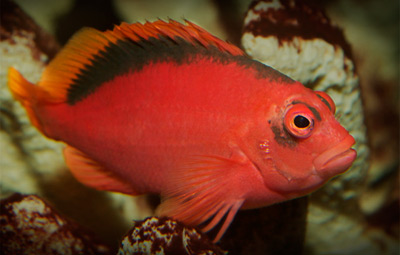I’ve long been a fan of the hawkfishes, and many a specimen has graced my various tanks over the years—most often the readily available and affordable (for me) Falco’s hawkfish (Cirrhitichthys falco). But another hawk that I’ve always found particularly endearing is Neocirrhites armatus, the flame hawkfish. Hobbyists looking for an eye-catching splash of color in a fairly small, hardy fish can’t go wrong with this species—though be warned that it can cost as much as three times what you might fork over for C. falco.
Physical traits
Looking like a little football (American-style) with fins, this bottom-dwelling species is bright red overall with black shading along the base of its dorsal fin and around the eyes. Unfortunately, this intense red is prone to fading in captivity. Typical of hawkfish, N. armatus has high-set eyes that seem to follow movement outside the tank with interest. The maximum length for this species is around 3.5 inches.
Feeding
N. armatus is not difficult to feed, with most specimens adapting to captive fare quite readily. Its diet in nature consists predominantly of small crustaceans, so items like mysids, krill, frozen formulations for small carnivores, and chopped mollusk/crustacean meat are good options. Dry offerings (such as New Life Spectrum) will likely be accepted as well. Once- or twice-daily feedings are sufficient.
Housing
As mentioned, N. armatus is a bottom-dwelling species that locomotes by hopping from place to place or swimming in short bursts. Like all hawkfishes, it’s usually found perched on a rock or corals, from which it will swoop down to capture prey. Thus, the availability of open swimming space is less of a concern than having ample rockwork arranged to provide ledges the hawk can perch upon. A tank somewhere between 20 and 30 gallons is suitable minimum housing.
Compatibility
N. armatus is relatively peaceful, but it may squabble with other fish species seeking to occupy the same niche in the tank and will treat small motile invertebrates—shrimps, snails, etc.—sharing its tank as a potential food source. It’s also safe to add this hawk to a reef system, but keep a close eye on it to make sure it’s not irritating corals or other sessile invertebrates by perching on them constantly. This behavior, if repeated too often, can cause the affected invertebrates to keep their tissues retracted to the extent that they don’t receive adequate light.



